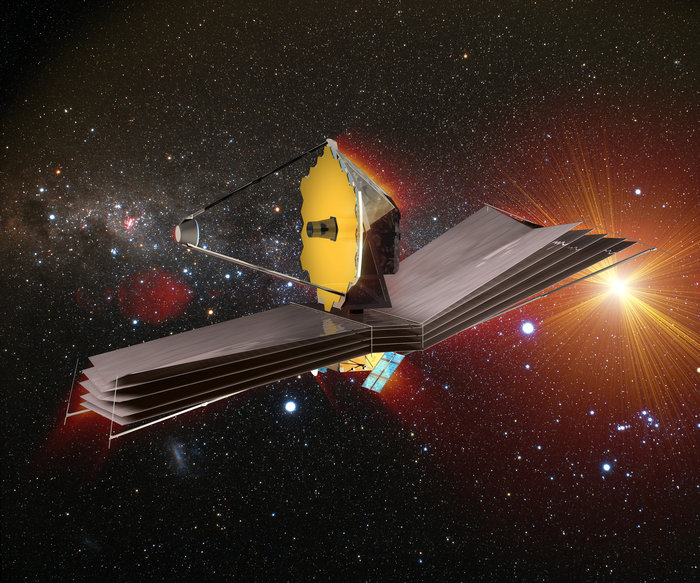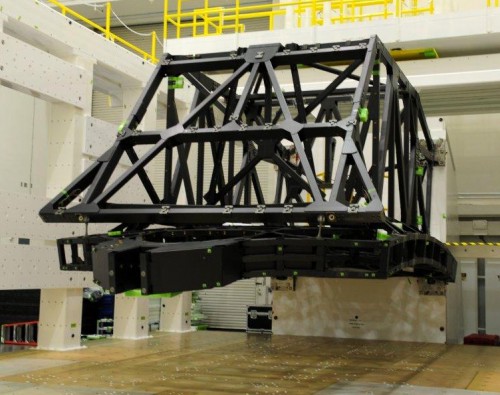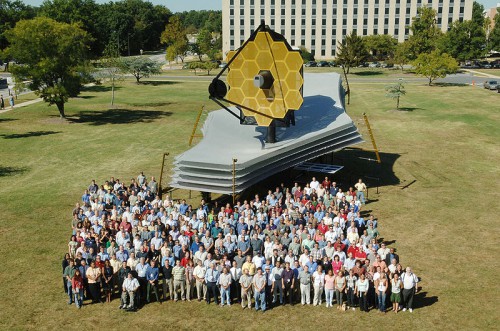
NASA announced on July 8 that it had completed static load testing on the James Webb Space Telescope’s (JWST) Primary Mirror Backplane Support Structure (PMBSS). The testing was completed by two of the contractors tapped to work on JWST, the Northrop Grumman Corporation and ATK. This latest developmental milestone moves the telescope closer to its intended launch aboard an Ariane 5 rocket, at current time scheduled to take place in October 2018 from the Guiana Space Centre in Kourou, French Guiana. Following its launch, the telescope will be “unfolded” and placed into an Earth-Sun Lagrangian point L2 “halo orbit,” where it will observe the cosmos.
NASA described the PMBSS assembly as “the stable platform that holds the telescope’s science instruments and the 18 beryllium mirror-segments that form the 21-foot-diameter primary mirror nearly motionless while the telescope peers into deep space.” The mirror’s structural integrity is of the utmost importance, being that it is the component that starlight will hit first. Lee Feinberg, NASA’s optical telescope element manager at Maryland’s Goddard Space Flight Center, discussed the essential nature of this testing phase.

“Static testing demonstrates the backplane has the structural integrity to withstand the forces and vibrations of launch and is the final test prior to starting the integration of the backplane with the rest of the telescope,” Feinberg emphasized. Scott Texter, optical telescope element manager at Northrop Grumman, seconded this assertion. He added: “This is the largest, most complex cryogenically stable structure humans have ever built. Completion of the static testing verifies it can hold the weight it is designed to hold. Now the structural backbone of the observatory is officially verified and ready for integration.”
NASA underscored that despite the structure’s large size and function, it has been engineered to be as lightweight as possible. The agency announced, “When fully deployed, [the PMBSS] measures approximately 24 feet tall by 19.5 feet wide by more than 11.5 feet deep, and weighs only 2,180 pounds.” However, despite its weight considerations, it is wholly supportive. The agency went on to state: “Once fully assembled and populated, the PMBSS will support a mission payload and instruments that weigh more than 7,300 pounds. With a full launch load, it will support the equivalent of 12 times its own weight.”
It has also been engineered to withstand the thermal stresses of space, which can occur due to uneven heating, leading to temperature differences across the structure. The PMBSS will not be able to move more than 38 nanometers, a distance merely the thousandth of the size of a human hair.
NASA stated the next step of the JWST’s construction will be to create the Optical Telescope Element structure (OTE). Once that step is complete, the OTE will be integrated with the telescope’s mirrors. Following that step, NASA and Northrop Grumman will run cryogenic tests on the PMBSS structure.
The JWST is a collaborative effort between NASA, the European Space Agency (ESA), and the Canadian Space Agency (CSA), with contributions from over a dozen other nations. A recent article by AmericaSpace’s Ken Kremer featured an interview with Dr. John Mather, a Nobel Prize-winning physicist who is the telescope’s senior project scientist at NASA. Dr. Mather spoke of how JWST will enable scientists and researchers the ability to look even farther into the universe than before, even with the last generation’s powerhouse space telescope (the Hubble Space Telescope, or HST).

“First, [JWST] can see farther in space and time. So it can look back towards the very first objects that formed after the Big Bang. Second, it can see inside dust clouds where stars and planets are being born today. Third, it can see things that are cold — like room temperature compared to stars. So it can pick up all kinds of things that are invisible to the Hubble telescope. And also that cannot be observed from the ground because the atmosphere of the Earth blocks the signals or it radiates infrared itself. So all that, plus JWST also being much bigger … The bigger part means that we’ll get a much sharper image. So it can see a lot farther,” Dr. Mather stated.
Despite JWST being more than four years away from its scheduled launch, excitement continues to build over this next-generation “portal to the stars.” Meanwhile, HST still continues to astound researchers, scientists, and amateur space watchers alike nearly a quarter of a century following its deployment. Most recently, it was announced it had discovered two Kuiper Belt Objects (KBOs) that could potentially be targeted by the New Horizons spacecraft as it makes its transit to Pluto.
A previous AmericaSpace article by Leonidas Papadopoulos discussed this breakthrough: “ … This discovery has earned the mission’s science team additional observing time on the space telescope for conducting a full-scale search in order to locate more such icy worlds, which could ensure an extended mission for New Horizons.” In the future, it is hoped the JWST will yield scores of similar, more intensive discoveries.
Be sure to “Like” AmericaSpace on Facebook and follow us on Twitter: @AmericaSpace
.
Missions » James Webb Telescope »


